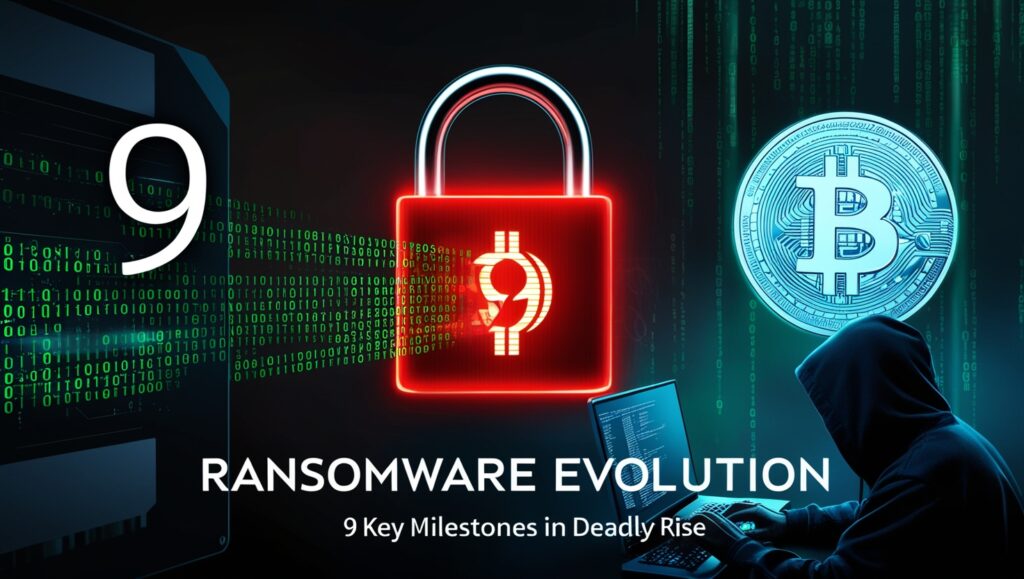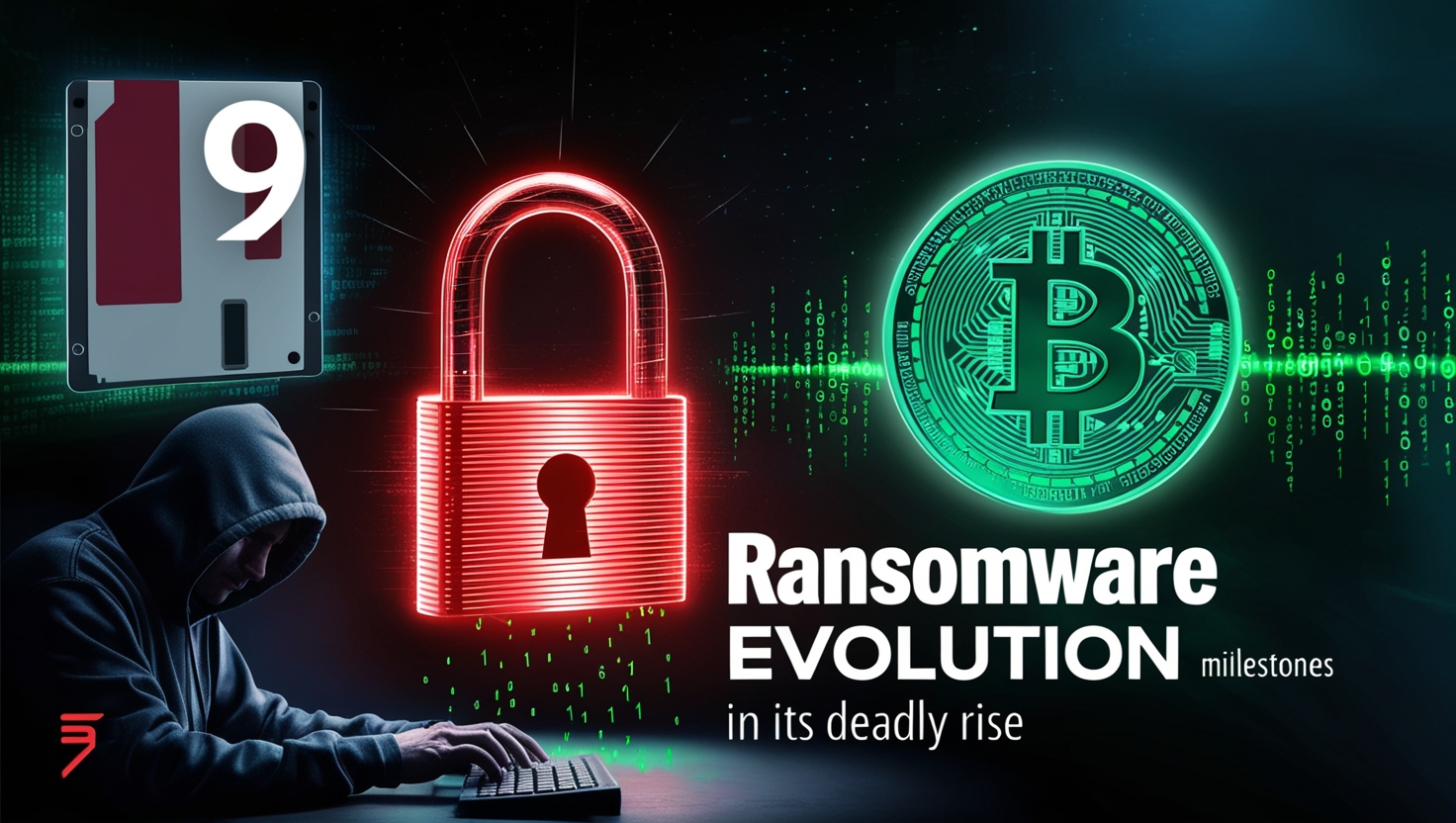The world of cybersecurity has been forever changed by the Ransomware Evolution, a journey that began with rudimentary floppy disk attacks and has grown into a sophisticated global menace. What started as a niche criminal tactic has morphed into a multi-billion-dollar industry, threatening individuals, businesses, and even nations. Let’s dive into the nine pivotal stages of this cyber scourge and see how it’s evolved over the decades.

1. The Early Days: From Floppy Disks to Digital Threats
Back in 1989, the Ransomware Evolution kicked off with the AIDS Trojan, one of the first documented ransomware attacks. Distributed via floppy disks mailed to researchers, it locked users’ files and demanded $189 to unlock them. This primitive approach relied on physical delivery and basic encryption, a far cry from today’s digital onslaughts. Early ransomware was more of a nuisance than a disaster, targeting individual users with limited reach. But it planted the seed for what would become a relentless cyber threat, proving that locking data for profit was a viable idea.
2. The Rise of Encryption: Ransomware Goes Sophisticated
Fast forward to the 2000s, and encryption became the game-changer in the Ransomware Evolution. Enter CryptoLocker in 2013—a strain that used military-grade encryption to lock files, demanding Bitcoin payments. Unlike its predecessors, CryptoLocker was nearly impossible to crack without paying up. This sophistication marked a turning point, shifting ransomware from petty scams to serious cybercrime. Criminals realized that strong encryption could hold data hostage effectively, setting the stage for bigger targets and bolder demands.
3. Ransomware-as-a-Service (RaaS): Crime Becomes a Business Model
By the mid-2010s, ransomware wasn’t just for tech-savvy hackers anymore. Ransomware-as-a-Service (RaaS) emerged, letting anyone with a grudge and a few bucks buy ready-made ransomware kits on the dark web. Think of it like a criminal franchise—developers create the malware, and “affiliates” deploy it, splitting the profits. Strains like REvil and Locky thrived under this model, making ransomware accessible to novices and amplifying its spread. This business-like approach turned a lone-wolf tactic into an organized industry.
4. Targeting the Big Fish: From Individuals to Enterprises
As the Ransomware Evolution progressed, attackers shifted their sights from random home users to high-value targets like corporations, hospitals, and governments. The 2017 WannaCry attack, which crippled the UK’s NHS and businesses worldwide, showcased this new focus. Big organizations meant bigger payouts—ransom demands soared into the millions. A single breach could paralyze operations, proving that enterprises were the juiciest targets. This shift highlighted how lucrative and disruptive ransomware had become.
5. Double Extortion: Beyond Just Locking Files
Around 2019, attackers upped the ante with double extortion. Now, they didn’t just encrypt files—they stole sensitive data first, threatening to leak it if the ransom wasn’t paid. The Maze gang pioneered this tactic, hitting companies with a one-two punch: pay to unlock your systems, then pay again to keep your secrets safe. This evolution made ransomware doubly devastating, as victims faced not just downtime but reputational ruin. It’s a chilling reminder of how ruthless these criminals have become.
6. The Role of Cryptocurrency: Fueling the Ransomware Boom
Cryptocurrency, especially Bitcoin, has been the rocket fuel behind ransomware’s rise. Its anonymous, untraceable nature lets attackers collect payments without fear of being caught. When CryptoLocker demanded Bitcoin in 2013, it set a precedent. Today, nearly every ransomware strain uses crypto for ransoms, from Monero to Ethereum. This financial innovation has made the Ransomware Evolution unstoppable, giving criminals a safe way to cash out while leaving law enforcement scrambling to keep up.
7. Global Impact: Ransomware as a Geopolitical Weapon
Ransomware isn’t just a criminal enterprise anymore—it’s a weapon in international conflicts. State-sponsored groups, like those tied to North Korea (e.g., Lazarus Group), have used ransomware to fund regimes and destabilize enemies. The 2021 Colonial Pipeline attack, linked to Russia-based DarkSide, shut down fuel supplies across the U.S. East Coast, showing how ransomware can cripple infrastructure. This geopolitical twist marks a dark chapter in its evolution, blending cybercrime with warfare.
8. Fighting Back: Evolution of Defenses and Law Enforcement
The good news? The fight against ransomware is evolving too. Cybersecurity firms now use AI to detect attacks in real time, while backups and zero-trust architectures help companies recover without paying. Law enforcement has also stepped up—take the 2021 REvil takedown by international agencies as proof. Governments are cracking down on crypto exchanges to cut off ransom flows, and public awareness is growing. While the Ransomware Evolution keeps advancing, so do our defenses, offering hope in this cat-and-mouse game.
9. The Future of Ransomware: What’s Next?
What’s on the horizon for the Ransomware Evolution? Experts predict AI-powered attacks that adapt faster than we can defend, targeting everything from smart homes to autonomous cars. Quantum computing could break today’s encryption, forcing a rethink of cybersecurity. Meanwhile, stricter regulations on cryptocurrency might slow ransom payments, but criminals will likely find new loopholes. The future is uncertain, but one thing’s clear: ransomware isn’t going anywhere—it’s just getting smarter.
10. FAQ Questions
Here are some common questions about the Ransomware Evolution:
- What was the first ransomware? The AIDS Trojan in 1989, spread via floppy disks.
- Why is ransomware so hard to stop? Strong encryption and anonymous payments make it tough to crack.
- Can I avoid paying a ransom? Yes, with good backups and security, but prevention is key.
- Will ransomware ever disappear? Unlikely—it’s too profitable, but defenses are improving.

Leave a Reply